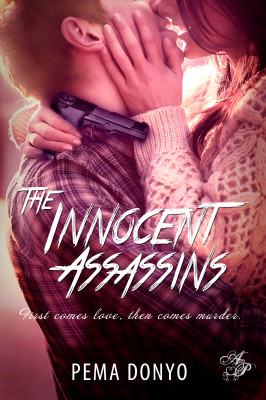Today we have a special guest post from Pema Donyo, the author of The Innocent Assassins. Please welcome her to Chapter Break.
Guest Post
New Adult books possess tropes. There’s the Reformed Bad-But-Not-That-Bad Boy trope, the She’s-Way-Too-Innocent-For-
But, amidst the dizzying array of rowdy frat parties and miraculous heroine makeovers, there’s one aspect of New Adult books I haven’t seen enough of:
Multicultural characters.
When scrolling through Amazon’s Best Sellers in New Adult & College Romance, the majority of covers feature white couples. Where are the African-Americans, the Chicanos, the Asians? There definitely are some NA novels with these characters, but they exist as an extremely small percentage of all NA books. How have non-white races somehow failed to materialize among more New Adult literature?
One of the amazing aspects of New Adult books is how fresh and exciting everything about the genre is. We’re just that – new. We communicate about books through social media; our heroes and heroines are at an age publishers would never consider before; we finally have a representation of who we are as a readership.
For such a fan-driven genre, the lack of racial diversity among books is startling. I’m not standing on a pillar, pointing at book covers, and crying, “There is no excuse!” Truthfully, the majority of stock images that cover designers work with are ones which feature white models. While my main character (Jane Lu) in my recent novel is Asian, you wouldn’t necessarily be able to tell from the cover. Cover artists have less models to work with once they’re not looking for a white model.
The issue of a lack of diversity among New Adult book characters is an institutional one. Institutions, however, can be changed. The very creation of New Adult was a result of rejecting the traditional publishing institution. Many early New Adult titles emerged from self-publishing – authors striking out on their own to take the world of literature by storm.
Like I said before, NA is a fan-driven genre. New Adult readers and writers don’t have to accept a lack of racial diversity among novels. Our genre is still in the early stages of development. We can be the force to finally embrace multicultural characters and represent all kinds of women and men.
 The Innocent Assassins
The Innocent Assassins
by Pema Donyo
Publication date: June 2014
Blurb: There are three rules to staying an assassin at the corporation of Covert Operatives: (1) your parents must be deceased, (2) your contracts must remain confidential, and (3) you must be under the age of eighteen.
After a murder mission goes awry a month before her eighteenth birthday, Covert Operatives assassin Jane Lu finds herself caught by the federal government and forced to spy for the CIA while remaining in Covert Operatives. Once her spying mission is over, she will be allowed to live a civilian life without facing criminal consequences—a life she’s only dreamed of having.
As Jane leaks information to the CIA, she uncovers secrets with enough power to both destroy Covert Operatives and her own boyfriend, Adrian King, who’s next in line to be CEO of the company. When her identity as a double agent for the CIA is discovered within Covert Operatives, she must decide where her allegiance, and her heart, truly lies.
About the Author:
Pema Donyo is a coffee-fueled college student by day and a creative writer by night. She currently lives in sunny Southern California, where any temperature less than 70 degrees is freezing and flip-flops never go out of season. As a rising sophomore at Claremont McKenna, she’s still working on mastering that delicate balance between finishing homework, meeting publisher deadlines, and… college. Her debut novel, The Innocent Assassins, is signed for publication with Astraea Press in June 2014. Catch up with her latest release information or writerly musings on her blog.
Website: http://pemadonyo.wordpress.com
Note: Some posts may contain affiliate links. Should you choose to purchase a product, we will receive a small commission for the sale at no additional cost to you. Chapter Break is a participant in the Amazon Services LLC Associates Program, an affiliate advertising program designed to provide a means for sites to earn advertising fees by advertising and linking to Amazon.com.



Great post! I haven’t noticed it before, I was simply thinking that one tends to write about people that sort of resembles one’s circle. So it’s “white on white” or something like that. But it is true, books should reflect society and it’s all sorts of cultures, colors, etc. now and each love story, regardless of the players, is just as beautiful as the next.
Braine Talk Supe recently posted…Year 3.2: Grim Shadows by Jenn Bennett + Roaring Twenties Giveaway
I agree Braine. I always thought you write what you know, and people tend to know their own culture best. But, we also see a lot of minority authors that do not write minority characters, so maybe that’s where the push is going now.
I think, too, that some people might feel intimidated to write about a culture that they are NOT part of. For instance, I am white, so if I write a minority character, will I get it right? Will I be criticized for not “getting it” right? Will I be seen as racist for having the main character white (like me) and the secondary character be a minority character?(be seen as a token “asian” character or whatever) Ultimately, I think you should write what you know…. and read what you don’t know. Simone Elkeles wrote her perfect Chemistry Series from the pov of a latino/hispanic male gang member…hmmmm how is that for writing outside of one’s culture? I think she does a decent job. But of course, I am not a hispanic gang member, so it is hard to say.